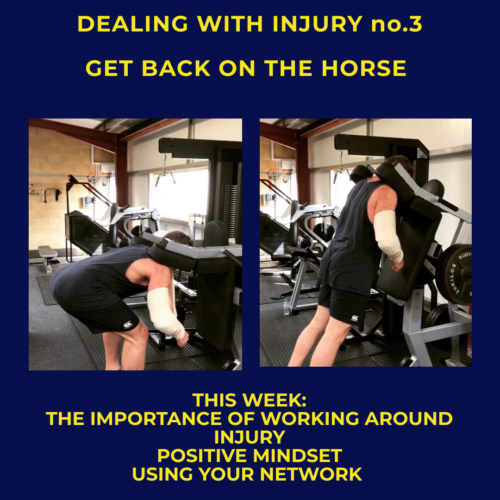
EPISODE 3: Back on the horse. How quickly should you get back to training following an injury?
If you haven’t read and watched last week’s episode in this series, you can do that here
To set yourself up for a speedy and rewarding return to play process, it is vital to continue your training routine as much as possible. Most injuries (those not requiring bed rest) can be worked around. Even those that lay you low for a while needn’t mean a complete break from routine.
Maintaining a regular routine of exercise despite incurring injury has several benefits:
· Staying fit and strong will shorten the recovery period by giving you fewer things to regain when the healing is done.
· New gains can be made by prioritising weak areas, whether that be joint health, mobility, calf capacity, neck training or more adductor bridges.
· Staying in your routine and training reinforces your sense of identity and integration, keeping you being who you are.
· Keeping energy expenditure high allows you to make less drastic changes to diet and nutrition, and offsets the common calorie surplus that accompanies restricted training.
You may be wondering how you can go about training with an injury, in my video part of this episode I show you:
· How to train lower body with an upper body injury
· How to maintain fitness using upper body training with a lower body injury
· A Torso circuit I used when my arm was injured
No Excuses
When I tore my bicep on a Sunday afternoon, I was in the gym on Monday. My thoughts were that there are over 1300 tendons in the human body, I snapped one, but that didn’t mean the rest of them deserved a holiday.
I’ll be returning to motivation and maintaining a positive mindset in more depth in a later post in this series, but this week I want to introduce the concept of No Excuses. This is something I have learned from working with the spinal injury community, both as athletes and rehabilitation clients over the past 10 years. It is relatively easy to keep training with one arm out of action, but what about when your injury is much more severe?
I have had the great privilege of working with dozens of athletes who had a reason to give up, stay home and let electronic devices and hired help do things for them, but didn’t. They persevered, adapting to their new body and crushing life with a positive attitude.
Seeing this kind of tenacity and a refusal to give in to excuses inspired me to approach injury rehabilitation in the same way. As a problem to be solved and overcome. The mindset that most clearly sums up what I mean by this is:
“Don’t focus on what you can’t do, focus on what you CAN do”.
Closing thoughts.
This stage is a good time to remind yourself of an action from step 1: reach out. I wanted to keep my lower body strong when my bicep was out of commission, so I hired a local personal trainer to put my legs through the meat grinder once a week for 10 weeks. I was able to put this aspect of training into his hands, just turn up and get after it. It was the highlight of my week and I saw substantial gains in my lower body in that time. Don’t go it alone – reach out and get help to keep you on track.
I am reminded of learning to ride and jump horses as a youngster (yes, horseback riding is extremely cool and tough). When we fell off the instructor would ensure we got back on as quickly as possible, before the tears had dried, or even stopped flowing.
It was sound practice. Stay in the game and you will succeed.
If you want to know more about managing injury or you need a custom designed return to play programme, contact me using the form below.
About the author : Edward Baker

Edward Baker is a University Lecturer, Researcher and Strength and Conditioning Coach with over 15 years’ experience working in elite sport.



